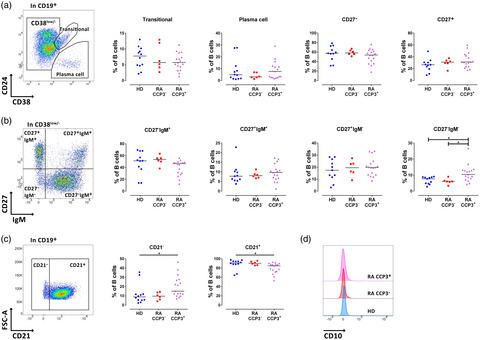当前位置:
X-MOL 学术
›
Clin. Exp. Immunol.
›
论文详情
Our official English website, www.x-mol.net, welcomes your feedback! (Note: you will need to create a separate account there.)
Atypical phenotype and response of B cells in patients with seropositive rheumatoid arthritis
Clinical & Experimental Immunology ( IF 4.6 ) Pub Date : 2021-01-18 , DOI: 10.1111/cei.13576 H Rincón-Arévalo 1 , M Rojas 1, 2 , A Vanegas-García 3 , C Muñoz-Vahos 3 , J Orejuela-Erazo 1 , G Vásquez 1 , D Castaño 1
Clinical & Experimental Immunology ( IF 4.6 ) Pub Date : 2021-01-18 , DOI: 10.1111/cei.13576 H Rincón-Arévalo 1 , M Rojas 1, 2 , A Vanegas-García 3 , C Muñoz-Vahos 3 , J Orejuela-Erazo 1 , G Vásquez 1 , D Castaño 1
Affiliation

|
Patients with rheumatoid arthritis (RA) may be classified as seropositive or seronegative according to the presence of autoantibodies. An abnormal B cell phenotype and function could be one of the main components of the immunopathology of seropositive patients; however, there is little information regarding B cell defects in these patients. This study shows a broad characterization of the B cell phenotype and function in patients with seropositive RA. We focused mainly on the evaluation of subsets, the expression of modulatory molecules of cell activation (CD22, FcɣRIIb and FcµR), calcium mobilization, global tyrosine phosphorylation, expression of activation markers, cytokine and immunoglobulin (Ig) production, proliferation and the in‐vitro generation of plasma cells. Increased frequency of CD27−IgM−IgD− and CD21− B cells was observed in patients with seropositive RA compared with healthy donors (HD). Decreased expression of CD22 was primarily found in memory B cells of patients with RA regardless of seropositivity. B cells from seropositive patients exhibited normal proliferation, calcium mobilization kinetics and global tyrosine phosphorylation, but showed an increased frequency of CD86+ B cells compared with HD. B cells of seropositive patients secrete less interleukin‐10 after in‐vitro activation and showed a decreased frequency of plasma cell differentiation and IgM production compared with HD. Our data indicate that patients with seropositive RA have an increased frequency of atypical B cell populations previously associated with chronic activation and antigen exposure. This may result in the observed low responsiveness of these cells in vitro.
中文翻译:

血清阳性类风湿关节炎患者 B 细胞的非典型表型和反应
根据自身抗体的存在,类风湿性关节炎 (RA) 患者可分为血清阳性或血清阴性。B 细胞表型和功能异常可能是血清阳性患者免疫病理学的主要组成部分之一;然而,关于这些患者的 B 细胞缺陷的信息很少。这项研究显示了血清阳性 RA 患者 B 细胞表型和功能的广泛特征。我们主要关注亚群的评估、细胞活化调节分子(CD22、FcɣRIIb 和 FcµR)的表达、钙动员、整体酪氨酸磷酸化、活化标志物的表达、细胞因子和免疫球蛋白 (Ig) 的产生、增殖和浆细胞的体外生成。CD27的频率增加- IgM - IgD -和 CD21 - B 细胞在血清阳性 RA 患者中与健康供体 (HD) 相比观察到。CD22 的表达降低主要见于 RA 患者的记忆 B 细胞,而与血清学阳性无关。来自血清阳性患者的 B 细胞表现出正常的增殖、钙动员动力学和整体酪氨酸磷酸化,但与 HD 相比,CD86 + B 细胞的频率增加。血清阳性患者的 B 细胞体外后分泌较少的白细胞介素-10与 HD 相比,活化并显示浆细胞分化和 IgM 产生的频率降低。我们的数据表明,血清阳性 RA 患者的非典型 B 细胞群的频率增加,以前与慢性活化和抗原暴露相关。这可能导致在体外观察到这些细胞的低反应性。
更新日期:2021-01-18
中文翻译:

血清阳性类风湿关节炎患者 B 细胞的非典型表型和反应
根据自身抗体的存在,类风湿性关节炎 (RA) 患者可分为血清阳性或血清阴性。B 细胞表型和功能异常可能是血清阳性患者免疫病理学的主要组成部分之一;然而,关于这些患者的 B 细胞缺陷的信息很少。这项研究显示了血清阳性 RA 患者 B 细胞表型和功能的广泛特征。我们主要关注亚群的评估、细胞活化调节分子(CD22、FcɣRIIb 和 FcµR)的表达、钙动员、整体酪氨酸磷酸化、活化标志物的表达、细胞因子和免疫球蛋白 (Ig) 的产生、增殖和浆细胞的体外生成。CD27的频率增加- IgM - IgD -和 CD21 - B 细胞在血清阳性 RA 患者中与健康供体 (HD) 相比观察到。CD22 的表达降低主要见于 RA 患者的记忆 B 细胞,而与血清学阳性无关。来自血清阳性患者的 B 细胞表现出正常的增殖、钙动员动力学和整体酪氨酸磷酸化,但与 HD 相比,CD86 + B 细胞的频率增加。血清阳性患者的 B 细胞体外后分泌较少的白细胞介素-10与 HD 相比,活化并显示浆细胞分化和 IgM 产生的频率降低。我们的数据表明,血清阳性 RA 患者的非典型 B 细胞群的频率增加,以前与慢性活化和抗原暴露相关。这可能导致在体外观察到这些细胞的低反应性。



























 京公网安备 11010802027423号
京公网安备 11010802027423号